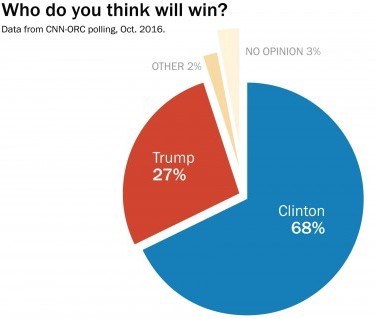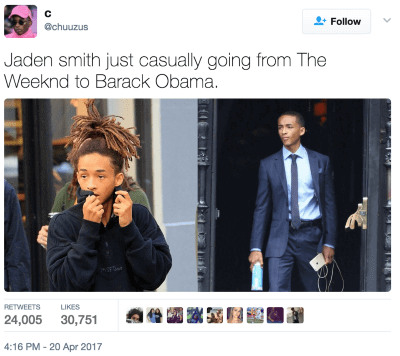If the platform is dead, we’re all living through a crossover episode of The Walking Dead and Silicon Valley.
I can’t count the number of clients and colleagues I’ve worked with over the years that have all made the same claim: Twitter is dead. They point to user growth, revenue, and stock prices. The problem with this argument is that it’s one crafted by the media and Wall Street, not by the consumers who use the platform.
 A clear indicator that data can sometimes literally mean nothing.
A clear indicator that data can sometimes literally mean nothing.
Does this sound familiar? I can’t help but see the resemblance to the 2016 election, when there was no feasible way that Donald Trump would win the election. If we’ve learned anything, it should be to question the data that clouds our echo-chambers.
Here are some things to consider before you become too keen on Twitter’s demise:
You (probably) aren’t a teenager
Teenagers are more likely to use Twitter than the platforms you’re including in your latest trend report. According to a recent report by GlobalWebIndex, Gen-Z is more likely to be active on Twitter (58%) than:
- WhatsApp (53%)
- Snapchat (41%)
- LinkedIn (27%)
- Tumblr (31%)
- Twitch (23%)
My favorite GIF of 2016
I AM NOT a Gary Vaynerchuck fan, but this GIF epitomizes this sentiment. In a blog post he wrote last year he shared his surprise when finding out that Twitter was the most popular platform in this teenager’s high school because it provides more natural interactions.
You’re (probably) underestimating “Black Twitter”
According to Pew Research Center, African Americans are 33% more likely to have a Twitter account than Caucasians, and four times more likely to use it daily.
But “Black Twitter” is more than just “the black community on Twitter”. It’s a movement––one that has drastically evolved the way we communicate (memes), our language (bae), and the way we protest (#blacklivesmatter).
You’re (probably) giving Fuck Jerry too much credit
Speaking of memes, Twitter is the foundation of the meme format you likely see every day. If you follow any of the following Instagram accounts, you interact with Twitter content regularly: The Fat Jewish, Girl With No Job, Daddy Issues, My Therapist Says, Fuck Jerry, etc.
The format of text being placed above an image originated from meme accounts taking screen shots of tweets and sharing them elsewhere––originally on 4chan and Reddit, then eventually Instagram.

 Proof that there is no such thing as fairness on the internet
Proof that there is no such thing as fairness on the internet
In 2015 The Fat Jewish was criticized on the national stage for this tactic, but has continued his thievery, only occasionally providing attribution.
You (probably) think Myspace is dead

Myspace still has 15M monthly users and receives over 300M video views monthly. It is clearly measly and pathetic in comparison to its former self, and one can argue a large portion of traffic is people visiting just to see if it still exists. Yet, the platform is not truly “dead”.
You’re (probably) functioning in Facebook’s dystopian reality
Social media isn’t new, but it’s sure as hell not predictable. All social platforms do not need astronomical growth over an extended period to survive.

Have your parents ever said to you, “why can’t you be more like [enter name here]?” We do this to every platform, asking them why they don’t have the growth, stock prices, or ad sales of Facebook.
Every platform does not need to be everything to everyone. Maybe the fact that Twitter doesn’t have the wide appeal of Facebook is what makes it such a strong community.
You’re (probably) too worried about engagement
Similarly, we shouldn’t be comparing engagement rates across platforms. Different platforms have different behaviors.
It’s no secret that brands organically get lower engagement on Twitter than they do on other platforms such as Instagram — according to Fan Bridge, approximately 3x lower on average.
If you’ve found a correlation between engagement rate and sales, please delete Twitter right now and focus your efforts elsewhere.
You (probably) haven’t read about last quarter
Twitter just announced its best user growth in years and reported revenue much higher than analysts expected. So, here’s my take on this cycle:
- People (particularly in specific communities) are using Twitter.
- Advertisers are not spending as much money there because they don’t understand the platform and see lower organic engagement.
- Wall Street is seeing weaker revenue than Facebook as a sign of Twitter’s demise and mainstream publishers are reporting as such.
- People are still using Twitter.
Build a social presence that makes sense for you and your consumers––not Wall Street.